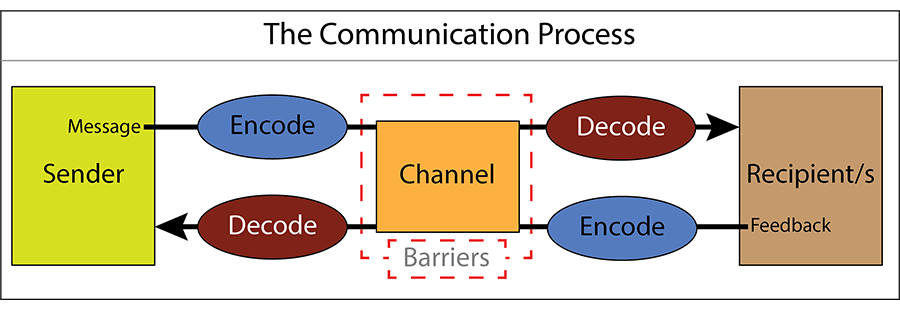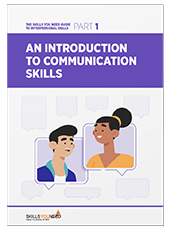Decoding Can Be Defined as the Process by Which Messages Are Put Into Symbolic Form.
Advice is but the deed of transferring information from one identify, person or grouping to another.
Every advice involves (at to the lowest degree) 1 sender, a bulletin and a recipient. This may sound simple, but advice is actually a very complex field of study.
The manual of the bulletin from sender to recipient can be afflicted by a huge range of things. These include our emotions, the cultural situation, the medium used to communicate, and even our location. The complexity is why good communication skills are considered and so desirable by employers around the world: accurate, effective and unambiguous advice is actually extremely difficult.
This page explains more nigh what we hateful past 'communication'.
Defining Communication
advice, due north. The imparting or exchanging of data by speaking, writing, or using another medium. …The successful conveying or sharing of ideas and feelings.
Oxford English Lexicon
Equally this definition makes clear, advice is more than but the manual of data. The term requires an element of success in transmitting or imparting a message, whether information, ideas, or emotions.
A advice therefore has three parts: the sender, the bulletin, and the recipient.
The sender 'encodes' the message, usually in a mixture of words and non-verbal communication. It is transmitted in some mode (for example, in speech or writing), and the recipient 'decodes' it.
Of grade, there may be more than one recipient, and the complexity of communication means that each i may receive a slightly different message. 2 people may read very different things into the choice of words and/or trunk language. It is also possible that neither of them will take quite the aforementioned understanding as the sender.
In face up-to-face communication, the roles of the sender and recipient are non distinct. The two roles will pass back and forrard betwixt two people talking. Both parties communicate with each other, fifty-fifty if in very subtle ways such as through center-contact (or lack of) and general torso language. In written communication, nevertheless, the sender and recipient are more distinct.
Categories of Communication
There are a wide range of ways in which we communicate and more than i may be occurring at any given fourth dimension.
The unlike categories of communication include:
-
Spoken or Verbal Advice, which includes face-to-face, telephone, radio or tv set and other media.
-
Non-Verbal Communication, covering torso language, gestures, how nosotros dress or act, where nosotros stand, and even our odor. There are many subtle means that nosotros communicate (perchance even unintentionally) with others. For instance, the tone of voice can give clues to mood or emotional state, whilst paw signals or gestures tin add to a spoken message.
-
Written Communication: which includes letters, e-mails, social media, books, magazines, the Cyberspace and other media. Until recent times, a relatively small number of writers and publishers were very powerful when information technology came to communicating the written word. Today, we tin all write and publish our ideas online, which has led to an explosion of information and communication possibilities.
-
Visualizations: graphs and charts, maps, logos and other visualizations can all communicate messages.
The desired effect or goal of any communication process is mutual agreement.
The Communication Process
A message or advice is sent by the sender through a advice aqueduct to a receiver, or to multiple receivers.
The sender must encode the bulletin (the data being conveyed) into a form that is appropriate to the communication channel, and the receiver(southward) and then decodes the message to understand its pregnant and significance.
Misunderstanding tin can occur at whatever stage of the communication procedure.
Effective communication involves minimising potential misunderstanding and overcoming any barriers to communication at each stage in the communication process.
See our page: Barriers to Effective Communication for more information.
An effective communicator understands their audience, chooses an advisable communication channel, hones their message to this channel and encodes the message to reduce misunderstanding by the receiver(s).
They volition too seek out feedback from the receiver(s) as to how the message is understood and attempt to correct whatsoever misunderstanding or defoliation as soon every bit possible.
Receivers tin can use techniques such every bit Clarification and Reflection as constructive means to ensure that the message sent has been understood correctly.

Advice Channels
Communication channels is the term given to the way in which nosotros communicate. It is therefore the method used to transmit our message to a recipient, or to receive a message from someone else.
There are multiple communication channels available to us today. These include face-to-face conversations, phone calls, text messages, email, the Internet (including social media such as Facebook and Twitter), radio and Television, written letters, brochures and reports.
Choosing an appropriate communication aqueduct is vital for effective communication. Each communication aqueduct has different strengths and weaknesses.
For example, dissemination news of an upcoming event via a written letter might convey the bulletin clearly to i or ii individuals. It volition not, nevertheless, be a time- or cost-effective manner to broadcast the message to a big number of people. On the other hand, conveying circuitous, technical information is easier via a printed document than a spoken message. The recipients are able to assimilate the information at their own pace and revisit anything that they do non fully understand.
Written communication is besides useful as a manner of recording what has been said, for example past taking minutes in a meeting.
Run into our pages: Note Taking and How to Carry a Meeting for more.
Encoding Messages
All messages must be encoded into a form that can exist conveyed by the communication channel called for the message.
We all practice this every day when transferring abstract thoughts into spoken words or a written form. However, other communication channels crave different forms of encoding, due east.g. text written for a written report will non work well if broadcast via a radio programme, and the brusque, abbreviated text used in text messages would be inappropriate in a letter or in speech.
Complex data may exist best communicated using a graph, chart or other visualisation.
Effective communicators encode their messages so that they fit both the channel and the intended audience. They use appropriate language, conveying the information simply and conspicuously. They also anticipate and eliminate likely causes of confusion and misunderstanding. They are more often than not aware of the recipients' feel in decoding similar communications.
Successful encoding of letters for the audience and channel is a vital skill in effective advice.
You may notice our page The Importance of Obviously English language helpful.
Decoding Messages
One time received, the recipient needs to decode the bulletin. Successful decoding is also a vital communication skill.
People will decode and understand messages in different ways.
This will depend on their experience and understanding of the context of the bulletin, how well they know the sender, their psychological country and how they feel, and the time and place of receipt. They may as well be affected by any Barriers to Communication which might be present.
There are therefore a wide range of factors that will touch on decoding and understanding.
Successful communicators empathize how the message volition exist decoded, and anticipate and remove as many as possible of the potential sources of misunderstanding.
Feedback
The terminal part of a advice is feedback: the recipient lets the sender know that they have received and understood the message.
Recipients of messages are likely to provide feedback on how they accept understood the messages through both verbal and non-verbal reactions. Effective communicators pay close attention to this feedback as it is the only manner to appraise whether the bulletin has been understood equally intended, and it allows any defoliation to be corrected.
Behave in mind that the extent and class of feedback volition vary with the communication channel. Feedback during a face-to-face or telephone chat will be immediate and direct, whilst feedback to messages conveyed via Boob tube or radio will be indirect and may be delayed, or even conveyed through other media such every bit the Internet.
Effective communicators pay close attention to this feedback as it is the merely fashion to assess whether the message has been understood as intended, and it allows whatsoever confusion to be corrected.
Y'all can always ask!
You may be unsure if a message has been successfully received and decoded, especially if yous practise not get much feedback from the recipient. If so, you can always ask!
A quick question is a good commencement, for example:
"Is that OK?" or "Are you clear nigh that?"
If yous desire more detailed feedback or to check that the recipient has really understood, you might say something like:
"So, let'southward just run over that i more time. I think I am going to practise x, and you are going to practise y. Is that your understanding too?"
Bear in listen that the extent and form of feedback will vary with the advice channel. Feedback during a face-to-face or telephone conversation will be firsthand and direct, whilst feedback to messages conveyed via TV or radio will be indirect and may be delayed, or even conveyed through other media such as the Cyberspace.
More on feedback: see our pages on Reflection, Description and Giving and Receiving Feedback .

Further Reading from Skills Yous Need
Our Communication Skills eBooks
Learn more nigh the key communication skills you need to exist an effective communicator.
Our eBooks are platonic for anyone who wants to learn about or develop their advice skills, and are full of easy-to-follow practical information and exercises.
Being able to communicate effectively is the most important of all life skills.
Understanding is the start footstep to comeback
Understanding more about communication and how information technology works is the first step to improving your advice skills. A good understanding of the process, and how information technology operates, will assistance you to become better at encoding and decoding letters.
Source: https://www.skillsyouneed.com/ips/what-is-communication.html
0 Response to "Decoding Can Be Defined as the Process by Which Messages Are Put Into Symbolic Form."
Postar um comentário